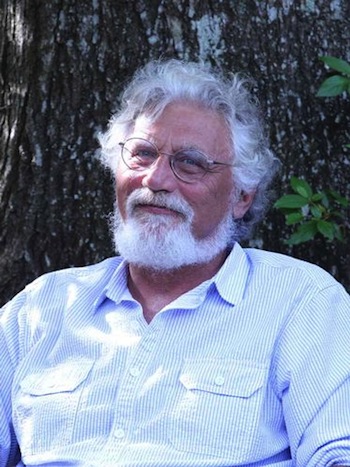Book Review: “The Woman Who Lost Her Soul” — A Lengthy Tale of Innocence Betrayed
Despite his weakness for overwriting, Bob Shacochis has a good and sad story to tell, and he gets through it with a certain mastery, especially in his dialogue and his creation of Dottie.
The Woman Who Lost Her Soul, by Bob Shacochis. Atlantic Monthly Press, 713 pp., $28.
By David Mehegan
In the prelude to this long novel, we find this paragraph:
But history walks on all of us, lashed by time, and sometimes we feel its boot on our backs, and sometimes we are oblivious to its passing, the swing of sorrow and triumph through humanity, sorrow, and then, finally, crippling grief fading to obscurity, which is perhaps why Americans want little to do with history, why perhaps they hate it, why prayer comes easier than remembrance, which is how history knots its endless endings and measures the rise and fall of its breath. And when history swirls around you and passes on and you inhale its aftermath, the bitterness of its ashes and the bygone sweetness of time, and excrete history into memory, you never quite believe you had once heard its thunderous God-like whispering, that you had trembled in the face of its terrible intimacies, and you fell silent.
Time, history, sorrow (twice), bitterness, triumph, grief, obscurity, prayer, remembrance, time, God, the “soul” of the title; thus are we alerted that this is to be a novel with classical sweep, in abstract themes and locations. It starts in Haiti in the 1990s, after the American military intervention to reverse a military coup; jumps back to the fratricidal end of World War II in Croatia, then ahead to turbulent Istanbul in 1986, and finally back to Haiti in the 1990s, all interwoven with scenes in Montana, North Carolina, Florida and elsewhere. It is classical also in its narrative mode. That early paragraph is Homeric; you can picture the bard in a Greek amphitheater, lyre in one hand and the other upraised (and since it’s Shacochis, a cigarette in his mouth), intoning this string of tropes about history, which lashes “you,” puts its boot on your back, swirls around you so that first you inhale its aftermath and then excrete it into memory. I have no idea what most of this means, but it’s large and it’s deep.
The novel begins with the death of a mysterious female American photographer on a lonely Haitian road in the chaotic aftermath of the American intervention. Tom Harrington, a human-rights lawyer with experience in Haiti, is enlisted to help solve the killing, partly because he knows the country and partly because he had had an encounter with “Jackie Scott” at the time of the U.S. intervention. I use quotation marks because the eponymous woman who loses her soul has several names throughout the book. Besides Harrington and the woman, the two other principal characters are her father, Steve Chambers, and a Delta Force commando with the improbable name of Eville Burnette. (We are told it is pronounced like Everest.)
Numerous secondary characters are denizens of the world of special operations, including assassinations and suchlike missions to battle terrorism and influence the outcome of fraught situations around the world deemed essential to U.S. interests. Among their assets is the army’s Delta Force, a branch of Special Forces similar to the Navy Seals. Chambers, nominally a diplomat but actually a CIA operative, is wholly immersed in this shadowy world, though it gradually becomes clear that his motives are not necessarily patriotic or peaceful. He has a score to settle and a white-hot animus toward communists and Muslims. Allied with him is a circle of amoral senior operatives known as the FOG or Friends of Golf: “The Friends of Golf believed themselves to be the true playwrights and producers of the narrative, adapted for a new generation of bloody thespians…. they were all hands of the Company, the commissars and satraps and water carriers of the Deep State, a familial nexus of assets and adjuncts, overt and covert and beyond into a netherworld of unidentifiable phantoms, daylighters and midnighters and cave dwellers.” At several of their stateside foursomes, the FOG hatch schemes in which Burnette is a central player. He too comes in contact with Jackie and it is largely through their growing entanglement that we learn who she is, how she became what she is, and the secrets of her fate.
The reader who finds this epic to be confusing at times is advised that the trouble is not in your set. It is often hard to figure out what exactly is going on, and that is not an accident. Partly it is due to the size of the canvas and the structure; you’re looking so closely that it’s difficult to get the big picture. Characters important early on disappear as the narrative lens shifts to another time and place, and by the time they reemerge you ask, “Right: Davor. Who is he again?” Besides that, this is the world of spookery and spec-ops, where everything is at least half-hidden, those who do understand what is going on never speak plainly, and never answer a direct question. Even Burnette, the main good guy in the book, is constantly scratching his head and saying words to the effect of, “I don’t get it. This doesn’t add up.” Yet he’s the “ours-not-to-reason-why” kind and keeps plunging ahead into things he understands but little. The book is a bit like a murder mystery in this manner of withholding information and letting it out a little bit at a time, except that mysteries are not usually 713 pages.
Shacochis must be a master researcher, unless he has an intimate personal acquaintance with Special Forces operations and the details of Haiti and Turkey in the 1980s and 90s, and Croatia in 1945. I do not know how accurate the macroscopic details of his Haitian voudou ceremony scenes are, but they seem convincing. All of his scenes, however brief, are furnished with meticulous detail; indeed, he writes from the school that believes you can’t have too many specific details. While this dense apparatus is impressive, it also makes for a longer book. When the Friends of Golf take a lunch break, for example, we are told it that it includes “pitchers of iced tea, two silver chafing dishes containing warm Kaiser rolls and Carolina pit barbecue, a serving bowl with cole slaw, a bottle of Trappey’s hot sauce.”
This drive for detail-packing produces some extraordinary sentences, as in this account of Burnette’s late father, who had also been a spec-ops guy: “For the next three years he’d pogo back and forth between his off-season secret war in Laos and the mountains of the Northwest, making babies and fighting blowups in Montana and Idaho, disappearing to Fort Carson in Colorado or Marana Airpark outside of Tucson for days and sometimes weeks to test R and D projects for special operations – a remote-control para-wing, a chute with a guidance system hooked to a frequency from a ground-to-air beacon, a Parachute Impact System that allowed pilots to stay out of the range of small-arms fire – then back on the weekends for barbecues on the ancestral ranch, home now to his own wife and his own children, and most everybody else in Montana who proudly shared the worthy name Burnette.” Shacochis has a way of making even a silent reader want to stop for a breath.

Author Bob Shacochis — he is part of a school that believes you can’t have too many specific details.
I have to disclose that this style, in which everything from Trappey’s Hot Sauce to the Parachute Impact System has to be named, is not my favorite kind of writing. The sort of stuff with the big foggy themes quoted above from the preface, to be found in much of the book, strikes me as pretentious, overwrought, melodramatic, and no doubt unintentionally amusing (excreting history? Ouch). I had been thinking, “The only thing this book lacks is a reference to the wine-dark sea and rosy-fingered dawn,” when I came to this sentence: “The sun rose red through a purpled cavalry of clouds marshaled along the horizon and after a while it spiked straight into her eyes and she could not look at it and looked away under the shield of her hand east along the ribbon of the island, thinking, it doesn’t look like a safe place, which she understood for some would be the island’s virtue.”
Nevertheless, Shacochis does have a good and sad story to tell, and he does get through it with a certain mastery, especially in his dialogue and his creation of Dottie. The plot of the story is actually fairly simple, notwithstanding the flood of meticulously wrought scenes. Who is Dottie (her real name), what is driving her, and what will become of her? At the start she is presented as a self-centered brat with a camera, but eventually she becomes a tragic figure, terribly used and abused, addicted to cocaine and danger. She cannot escape the diabolical control of her father, who is morally and in the end literally a madman.
Shacochis spends considerable time in Dottie’s mind and chaotic emotions, and though perhaps female readers will disagree, she is to me a more interesting and more fully realized character than most of the men. I don’t understand about her losing her soul, but she is to be sure a lost soul. Despite the hardness and violence of his profession, Burnette is a decent sort who falls in love with her, and we come to think and hope that he might succeed in the spec-op for which he is not trained, which is to extract her from the nightmarish life into which she has been manipulated. All the minute details and the intricate plotting of the spooks and the derring-do and the vivid scenes are entertaining, but the heart of the book is not confusing or complicated: it is the ruination of the innocent by those whom they have a right to trust.
David Mehegan is a contributing writer. He can be reached at dmehegan@gmail.bu.edu.

